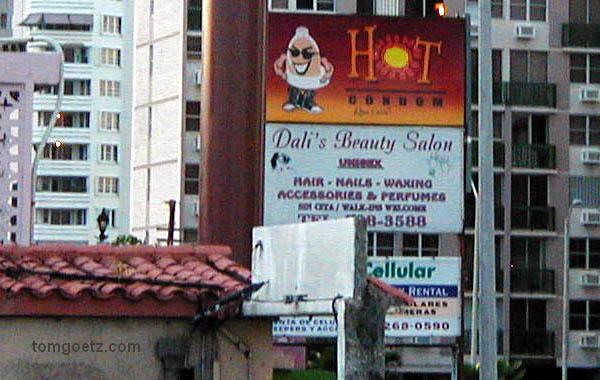Monday, October 6, 2003
Today we visit Old San Juan. The city bus goes from Isla Verde to the old city for only 25 cents and leaves a block from our hotel. The A5 is supposed to come by every seven minutes, but we waited about 20. We couldn't possibly take a Latin American vacation totally devoid of bus action! Our driver, "Captain Danger," delighted in approaching traffic as fast as possible and then slamming on the brakes and stopping two inches from the next bumper. I'm sure he's not still alive. The ride took 40 minutes and ended at the bus station in Old San Juan, where we hopped on a free trolley to the Castillo de San Cristóbal.
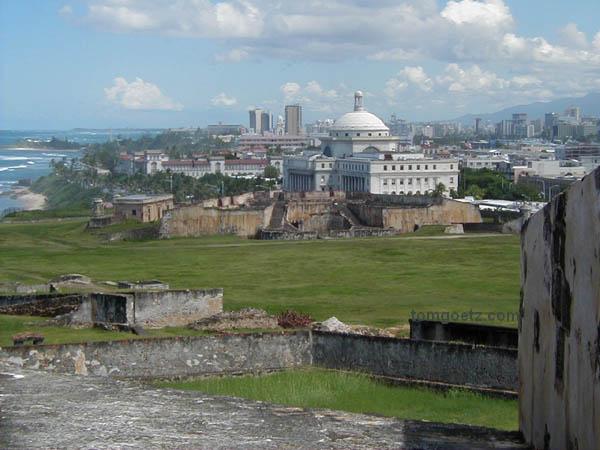
San Juan from el Castillo de San Cristóbal
Old San Juan, estabished in 1521, is a 500-year-old, seven-square-block, walled city originally built as a military stronghold but now a residential and commercial district. Spain built a number of forts in the Caribbean and the Gulf of Mexico to protect its New World possessions from the likes of the English, the French, and the Dutch, whose ships regularly attacked Spanish shipping and towns, but none were considered more critical than San Juan harbor. The forts located here are the oldest European fortifications within the United States.
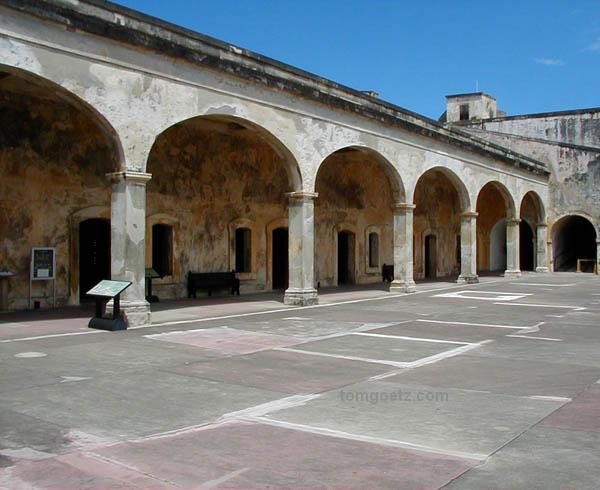
Castillo de San Cristóbal courtyard
El Castillo de San Cristóbal is the largest of San Juan's forts. It was built to protect from land approaches to San Juan from the east. It was from here, in 1898, that Spanish troops fired the first shot of the Spanish-American War in Puerto Rico, toward an American ship in the Atlantic. They missed. San Cristóbal has 150-foot walls, moats, bridges, tunnels, and all that cool fort/castle stuff, and presents striking views of the Atlantic, La Perla, and the other major fort in San Juan, San Felipe del Morro. It is also the less visited of the two major fortifications. We were there an hour and a half and briefly saw only two other couples. Admission $3.
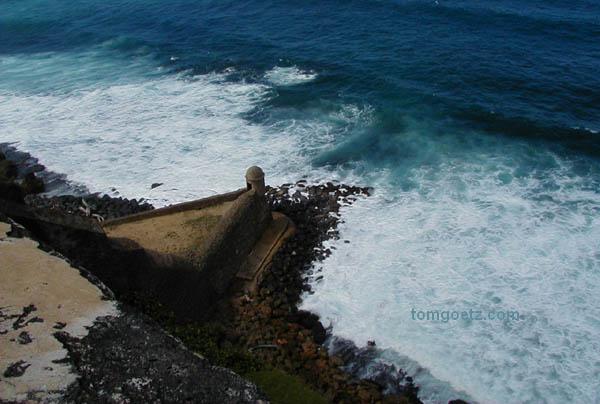
Devil's sentry box
We walked west on Calle Norzagaray along the city wall toward El Castillo de San Felipe del Morro. A road and steps lead outside the wall to the community of La Perla, called "the most picturesque slum in the world." Our guidebook warned to under no circumstances wander into this neighborhood. My skeptical nature made me think they were exagerating the danger, but we heeded their warning nonetheless.
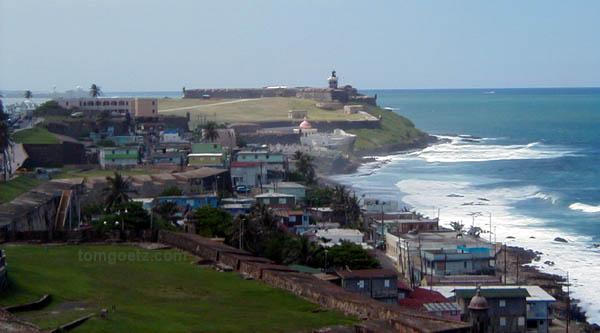
La Perla and el Castillo del Morro
Ah-ha! This is where all the people are who weren't at the first fort. Still, it wasn't terribly crowded. We just had to be careful to stay ahead of the cruise shippers. Luckily, they travel as a pack. Later in the day Tom and I got separated by what we've dubbed "the silver dot gang." Each group of package tourists we saw would wear a different colored sticker to identify their particular herd in the wild, i.e., off the cruise ship, and the silver dots were a particularly aggressive group. Tom was swept away in the crowd for half a block before he was able to separate from the collective and rejoin me.
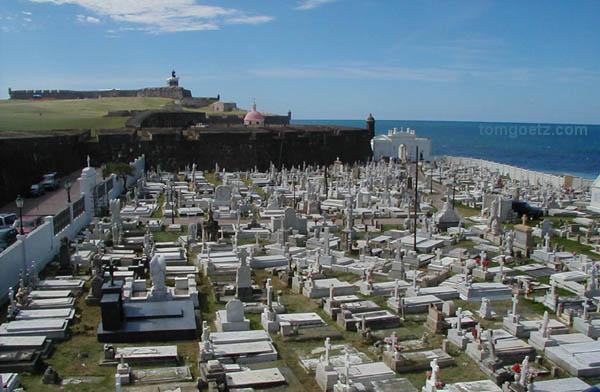
El Cemetario de San Juan
El Castillo del Morro was built in 1539 to guard against sea attack and is the oldest Spanish fort in the New World. It sits dramatically on a cliff overlooking the ocean and the Cemetario de San Juan. A lighthouse has stood on its top level since 1846 and is still in use today. The observation decks on El Morro were used as a World War I cannon emplacement by the U.S. military, and from 1942 until the end of World War II, 90mm anti-aircraft artillery sat here. Another great fort with stunning views. Admission $3.
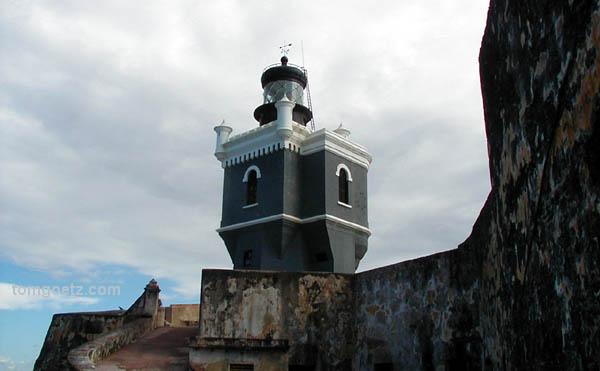
El Castillo del Morro lighthouse
Guess what. We got all busy and didn't eat again. By four o'clock we were once again famished. In our search for food, all we could find at first was a place selling $8 burgers. That just seems excessive. Then a bit further down the road we came to the Plaza de Armas and ate lunch at Wendy's. Thank you, Dave Thomas. The Plaza also has a Burger King and a Walgreens. Convenient, yes. Charming, not so much, though the plaza still has some remnants of its colonial character.
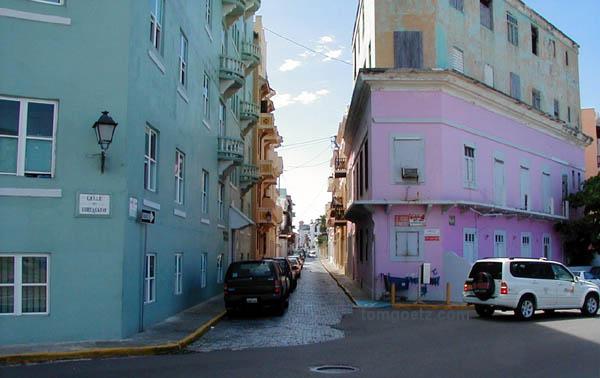
Colorful Old San Juan
We thought the Plaza de Armas had a lot of pigeons until we discovered the Parque de las Palomas (Pigeon Park). A vendor by the entrance sells bird seed, and particularly insane Christians believe that if you feed the birds and one "anoints" you, you have been blessed by God. GROSS! There were two ladies feeding the birds while we were there and letting them land all over them. It was practically a scene from an Alfred Hitchcock movie.
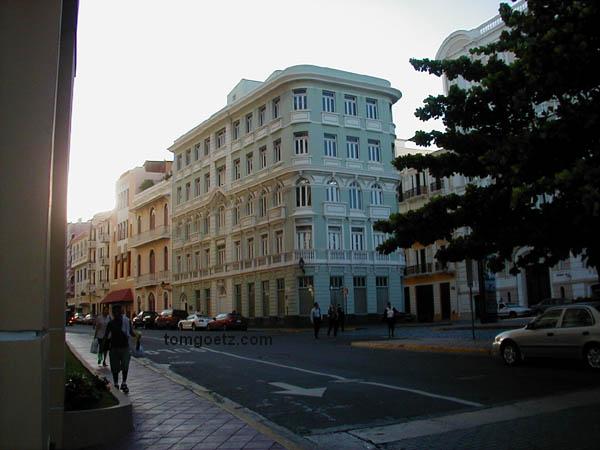
Colonial Old San Juan
Next to the Pigeon Park is the Capilla del Santo Cristo de la Salud (Chapel of Christ the Savior), a tiny, centuries-old outdoor chapel at the top of the city wall. The capilla is built where a horse and rider participating in a race purportedly ran off the top of the wall and into the sea and miraculously survived. Believers travel to this chapel and leave on the altar little silver ornaments representing body parts as thanks for being cured.
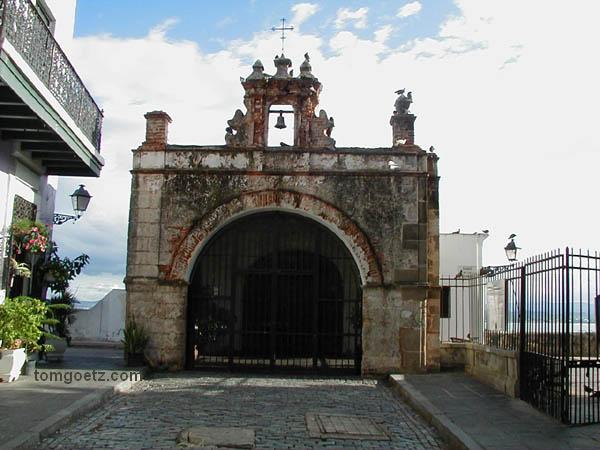
El Capilla del Santo Cristo de la Salud
La Puerta de San Juan, dating from 1639, is the oldest of three surviving gates through San Juan's city wall. The massive wooden doors used to close at sundown to protect the residents of Old San Juan. We exited through the gate to the Paseo de la Princesa (Walkway of the Princess), a promenade along the San Juan Bay. The paseo is very popular with cats. We counted at least nine hanging out around the rocks. There are a few cool sculptures along the paseo, most notably Raíces (Roots), a sculpture and fountain depicting the Taíno Indian, European, and African roots of Puerto Rico. Here's a page with a few of the sculptures.
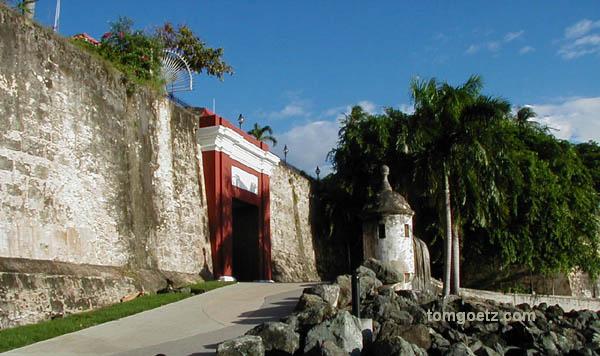
La Puerta de San Juan
We had to walk past the docked cruise ships to get back to the bus station. Adjacent to the cruise ship port is a Señor Frog's, and it was PACKED. Imagine spending your vacation cruising from port to port, seeing the same group of people at each Señor Frog's. You might as well stay in one place. Not our idea of fun.
The bus ride back to the hotel was without incident. Our bus driver from this morning was surely dead by now, so we rode with someone sane. Tom bought some Cuban cigars on the way back to the hotel (don't tell the Feds), then we drank cervezas and swam. Out at the pool we met six people from the British Virgin Islands, mainly from Tortola, BVI's main island. They were stopping for the night in San Juan on their way home from a convention at Opryland, in Nashville, Tennessee! Gerald tried to involve Tom in a Ponzi scheme, but I dragged him away.
